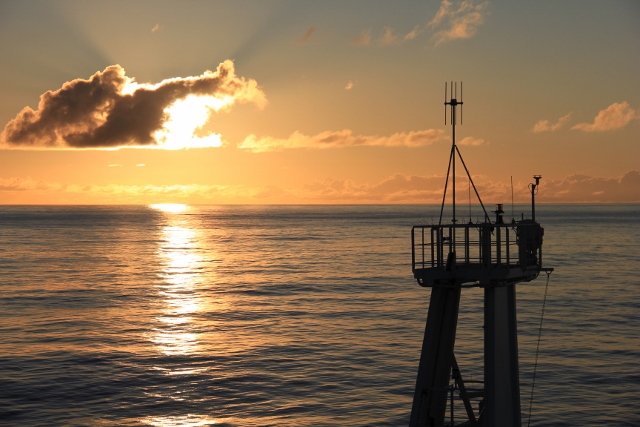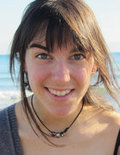Seitenpfad:
- Presse
- UlLTRAPAC: Quer über den Pazifik
UlLTRAPAC: Quer über den Pazifik
Die Inhalte dieser Seite sind leider nicht auf Deutsch verfügbar.
Today on 31 December 2015 we got the second message from the Sonne Crew.
Clara writes:
"Towards the Gyre
During the last week, the UltraPac expedition has successfully covered its first stations. After moving away from the Chilean coast we continue to steam West into the heart of the Gyre, where we will be crossing the regions furthest away from continental land that exist on Earth. Being so far away from land, no dust particles make it to this ocean region and as a result (together with the physical characteristics of the gyre) these waters have extremely low nutrient concentrations. They are termed "ultra-oligotrophic", which is what our expedition "Ultra-Pac" is named after. The scarcity of nutrients limits surface eukaryotic life, resulting in the clearest waters existing on Earth, but also the largest desert on the planet. There is life in these waters, though: up to a million of tiny microbes can be found in every drop of seawater and survive in these harsh conditions, sometimes creating their own nutrients (such as bioavailable nitrogen).
The South Pacific Gyre may be the largest region on Earth unaffected by humans. However, due to its remoteness, we know very little about it (less than 30 expeditions have crossed these waters since 1905). Thus, the best way to explore this region is studying its chemistry and microbiology and it is for this reason that the South Pacific Gyre is a fascinating location for marine chemists and marine microbiologists. On board we can find seven different groups studying all kinds of parameters to characterize these waters.
In practice, when we reach a station, we sample in parallel to have a complete dataset. We collect water samples from the very surface to the very deep (about 4000 meters) that meet everyone's demands. Water samples are precious, and have to be strictly rationed when the rosette comes on board. It is not unlikely to see a queue of people waiting, each with all sorts of bottles, eager to get hold of their part of water samples.
For the more demanding, pumps are deployed at a certain depths to filter large volumes of water "in situ". Here you see them dry, ready to be used, dressed for the occasion on Christmas Eve. For the very scarce eukaryotes, plankton nets concentrate any large organisms (by "large" we refer to larger than 10 micrometer, still invisible to the naked eye, but much larger than microbes). There are several other devices that will be presented in due time. Not all of them are used to collect water samples, some are designed for the ancient deep sediment."
Clara Martinez Perez
Clara writes:
"Towards the Gyre
During the last week, the UltraPac expedition has successfully covered its first stations. After moving away from the Chilean coast we continue to steam West into the heart of the Gyre, where we will be crossing the regions furthest away from continental land that exist on Earth. Being so far away from land, no dust particles make it to this ocean region and as a result (together with the physical characteristics of the gyre) these waters have extremely low nutrient concentrations. They are termed "ultra-oligotrophic", which is what our expedition "Ultra-Pac" is named after. The scarcity of nutrients limits surface eukaryotic life, resulting in the clearest waters existing on Earth, but also the largest desert on the planet. There is life in these waters, though: up to a million of tiny microbes can be found in every drop of seawater and survive in these harsh conditions, sometimes creating their own nutrients (such as bioavailable nitrogen).
The South Pacific Gyre may be the largest region on Earth unaffected by humans. However, due to its remoteness, we know very little about it (less than 30 expeditions have crossed these waters since 1905). Thus, the best way to explore this region is studying its chemistry and microbiology and it is for this reason that the South Pacific Gyre is a fascinating location for marine chemists and marine microbiologists. On board we can find seven different groups studying all kinds of parameters to characterize these waters.
In practice, when we reach a station, we sample in parallel to have a complete dataset. We collect water samples from the very surface to the very deep (about 4000 meters) that meet everyone's demands. Water samples are precious, and have to be strictly rationed when the rosette comes on board. It is not unlikely to see a queue of people waiting, each with all sorts of bottles, eager to get hold of their part of water samples.
For the more demanding, pumps are deployed at a certain depths to filter large volumes of water "in situ". Here you see them dry, ready to be used, dressed for the occasion on Christmas Eve. For the very scarce eukaryotes, plankton nets concentrate any large organisms (by "large" we refer to larger than 10 micrometer, still invisible to the naked eye, but much larger than microbes). There are several other devices that will be presented in due time. Not all of them are used to collect water samples, some are designed for the ancient deep sediment."
Clara Martinez Perez
What is an oceanic gyre?
An oceanic gyre is a rotating systems of currents caused by the interactions of wind systems and the rotational effect of the earth. The Coriolis effect describes the directional change of movement: Winds and currents in the Southern hemisphere are deflected leftward, in the Northern hemisphere to the right. The main wind systems are the trade winds caused by a low pressure system around the equator. Southern surface winds streaming into this low pressure systems are deflected to the left, i. e. they blow from Southeast. They are acting on the water causing a current then rotating counter clockwise in the South Pacific.
Read more on wikipedia.
An oceanic gyre is a rotating systems of currents caused by the interactions of wind systems and the rotational effect of the earth. The Coriolis effect describes the directional change of movement: Winds and currents in the Southern hemisphere are deflected leftward, in the Northern hemisphere to the right. The main wind systems are the trade winds caused by a low pressure system around the equator. Southern surface winds streaming into this low pressure systems are deflected to the left, i. e. they blow from Southeast. They are acting on the water causing a current then rotating counter clockwise in the South Pacific.
Read more on wikipedia.
Contact:
Dr. Manfred Schloesser
Press officer
Tel.: +49 421 2028 704
Mail: mschloes(at)mpi-bremen.de
Dr. Fanni Aspetsberger
Press officer
Tel.: +49 421 2028 645
Mail: faspetsb(at)mpi-bremen.de
Dr. Manfred Schloesser
Press officer
Tel.: +49 421 2028 704
Mail: mschloes(at)mpi-bremen.de
Dr. Fanni Aspetsberger
Press officer
Tel.: +49 421 2028 645
Mail: faspetsb(at)mpi-bremen.de
Clara Martinez Perez
Want to learn more about the cruise? Watch our video on youtube. Sorry, in German only.
Want to know where the RV Sonne is?
Click here
Click here
31 December 2015
Position S 23°30' W 100°
Position S 23°30' W 100°
S 23°30' The Tropic of the Capricorn
At the winter solstice, 21 December, the sun reaches its highest point at noon in the zenith. This is because the earth´s axis is tilted around 23°30'. The RV Sonne is going west following the Troipc of the Capricorn on this latitude. The name was coined 2000 years ago when the sun´s position was in the constellation Capricorn as seen from the earth. Read more on Wikipedia.
At the winter solstice, 21 December, the sun reaches its highest point at noon in the zenith. This is because the earth´s axis is tilted around 23°30'. The RV Sonne is going west following the Troipc of the Capricorn on this latitude. The name was coined 2000 years ago when the sun´s position was in the constellation Capricorn as seen from the earth. Read more on Wikipedia.




